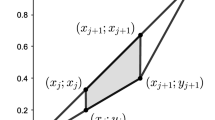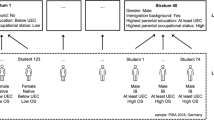Abstract
There are many situations in which measures of the full diversity of a collection of distributions is necessary and where simple comparisons of limited numbers of distributional moments are inadequate since they cast a veil of ignorance over the full extent of distributional differences. An example is the equality of opportunity imperative which demands equal chances for diverse circumstance groups. It requires comparison of distributional differences over the full range of their variation since only then can complete equality of chances be guaranteed. Here new techniques in the form of Gini-like coefficients for quantifying multilateral distributional differences in absence of cardinal comparability are introduced and employed to study changes in the German educational system in the first decade of this century.


Similar content being viewed by others
Notes
This simple formulation nicely illustrates the problem highlighted in the Carniero et al. [13] critique in that just seeking equality in means ignores or masks potential variability in variance which would reflect important differences in high and low achievers.
The choice of normal densities depend on the assumption of normality in effort. However this is not an overly strong assumption since, any continuous distribution can be approximated to some desired degree of accuracy by an appropriate finite Gaussian mixture [34].
It is well known that the likelihood function of normal mixtures is unbounded and the global maximizer does not exist [25]. Therefore, the maximum likelihood estimator of \({\varvec{\Psi }}\) should be the root of the likelihood equation corresponding to the largest of the local maxima. The usual solution is to apply a range of starting values for the iterations. In this paper, randomly selected large sample, non-hierarchical clustering-based starts, are employed [21].
A matrix T has a quasi-maximal diagonal when there exists positive \(\alpha _1, \ldots , \alpha _k, \ldots , \alpha _K\) such that \(\alpha _k t_{kk} \ge \alpha _j t_{kj}\), for all k, j. Restricting the analysis to the subset of quasi-maximal diagonal matrices reconciles the axioms of Perfect Mobility and Monotonicity as shown for the Shorrocks’s mobility index [38].
When classes are large in number it is possible to study and assess polarization and convergence to multiple poles in a similar fashion but it is not necessary in this case.
German school tracking, long viewed as in institutional device reinforcing the intergenerational persistence in educational achievements across different social classes has been the object of considerable study (for an excellent survey see [23]).
It would be also interesting, and left for future research, to investigate the progress in EO separately for gender and other students’ characteristics. Moreover, in this paper we are interested in an overall evaluation of the skills mastered by students at the age of 15, but a more comprehensive understanding could emerge from the analysis of each discipline since similar achievement index may reflect different scores for each field. Actually, correlation between test scores in each field is not strong. Correlation between test scores in 2003 shows a moderate positive correlation between reading and mathematical literacy (\(\rho =0.534\)), a moderate correlation between reading and science (\(\rho =0.367\)), while correlation between science and math is negligible (\(\rho =0.067\)). Interestingly, in 2009 correlation between science and math becomes positive and significant (\(\rho =0.460\)), the correlation between reading and science becomes negative (\(\rho =-0.277\)), while correlation between reading and math remains moderately positive (\(\rho =0.405\)).
An extensive discussion of context indicators is, e.g., in [18].
Circumstances could be treated in a similar semiparametric fashion but the technique yielded a variable which was effectively discrete with just 20 points of support.
A Gaussian kernel density estimator was employed. The bandwidth has been estimated using the plug-in procedure of [37].
Widely-used parsimony-based criteria (AIC, AIC3, CAIC, BIC) confirm that in 2003 the prevalent choice is three components and that in 2009 is definitely four components.
References
Akaike, H.: Information theory and an extension of the maximum likelihood principle. In: Proceedings of the 2nd International Symposium on Information Theory to Problems of Control and Information Theory, pp. 267–281 (1972)
Anderson, G.: Measuring aspects of mobility, polarization and convergence in the absence of cardinality: indices based upon transitional typology. Soc. Indic. Res. 139, 887–907 (2018)
Anderson, G., Leo, T.W., Muelhaupt, R.: Measuring advances in equality of opportunity: the Changing gender gap in educational attainment in Canada in the last half century. Soc. Indic. Res. 119, 73–99 (2014)
Anderson, G., Leo, T.W.: Quantifying the progress of economic and social justice: charting changes in equality of opportunity in the USA, 1960–2000. J. Hum. Dev. Capab. 18(1), 17–45 (2017)
Anderson, G., Linton, O., Whang, Y.-J.: Nonparametric estimation and inference about the overlap of two distributions. J. Econom. 171(1), 1–23 (2012)
Anderson, G., Linton, O., Pittau, M.G., Whang, Y-J, Zelli, R.: Are eurozone household income distributions converging? Introducing MGT and DisGini, new tools for multilateral distributional comparisons. Department of Economics Working Papers-657, University of Toronto (2020)
Arrow, K.J., Bowles, S., Durlauf, S.N.: Meritocracy and Economic Inequality. Princeton University Press, Princeton (2000)
Atkinson, A.B.: Public economics after the idea of justice. J. Hum. Dev. Capab. 13(4), 521–536 (2012)
Avenarius, H., Ditton, H., Döbert, H., Klemm, K., Klieme, E., Rürup, M., Tenorth, H.E., Weishaupt, H., Weiß, M.: Bildungsbericht Für Deutschland, pp. 258–282. Leske Budrich, Opladen (2003)
Becker, G.S., Tomes, N.: Family capital and the rise and fall of families. J. Labor Econ. 4, 31–39 (1986)
Brady, D.S., Barber, H.A.: The pattern of food expenditures. Rev. Econ. Stat. 30, 198–206 (1948)
Brunello, G., Checchi, D.: Does school tracking affect equality of opportunity? New international evidence. IZA Discussion Paper No. 2348 (2006)
Carneiro, P., Hansen, K.T., Heckman, J.J.: 2001 Lawrence R. Klein lecture estimating distributions of treatment effects with an application to the returns to schooling and measurement of the effects of uncertainty on college choice. Int. Econ. Rev. 44, 361–422 (2003)
Chwialkowski, K., Ramdas, A., Sejdinovic, D., Gretton, A.: Fast two-sample testing with analytic representations of probability measures. Adv. Neural Inf. Process. Syst. (NIPS) 28, 1981–1989 (2015)
Coleman, J.S., Campbell, E.Q., Hobson, C.J., McPartland, J., Mood, A.M., Weinfeld, F.D., York, R.L.: Equality of Educational Opportunity. Office of Education, US Department of Health, Education and Welfare, Washington, D.C. (1966)
Dardanoni, V., Fiorini, M., Forcina, A.: Stochastic monotonicity in intergenerational mobility tables. J. Appl. Econ. 27(1), 85–107 (2010)
Dempster, A.P., Laird, N.M., Rubin, D.B.: Maximum likelihood from incomplete data via EM algorithm. J. R. Stat. Soc. B 69, 1–38 (1977)
Duru-Bellat, M., Suchaut, B.: Organisation and context, efficiency and equity of educational systems: what PISA tells us. Eur. Educ. Res. J. 4(3), 181–194 (2005)
Gini, C.: l concetto di transvariazione e le sue prime applicazioni. Giornale degli Economisti e Rivista diStatistica, pp. 1–55 (1916)
Greenwood, P.E., Nikulin, M.S.: A Guide to Chi-squared Testing. Wiley, New York (1996)
Kaufman, L., Rousseeuw, P.J.: Finding Groups in Data: An Introduction to Cluster Analysis. Wiley, New York (1990)
Kobus, M., Milos, P.: Inequality decomposition by population subgroups for ordinal data. J. Health Econ. 31, 15–21 (2012)
Krause, A., Schüller, S.: Evidence and persistence of education inequality in an early-tracking system—the German case. FBK-IRVAPP Working Paper No. 2014-07 (2014)
Lefranc, A., Pistolesi, N., Trannoy, A.: Equality of opportunity and luck: definitions and testable conditions, with an application to income in France. J. Public Econ. 93, 1189–1207 (2009)
McLachlan, G., Peel, D.: Finite Mixture Models. Wiley, New York (2000)
Mosteller, F., Moynihan, D.P. (eds.): On Equality of Educational Opportunity. Random House, New York (1972)
Nickell, S.: Poverty and worklessness in Britain. Econ. J. 114, C1–C25 (2004)
OECD: Strong Performers and Successful Reformers in Education: Lessons from PISA. OECD Publishing, Paris (2011)
Peragine, V., Palmisano, F., Brunori, P.: Economic growth and equality of opportunity. World Bank Econ. Rev. 28, 247–281 (2014)
PISA 2000-Zentrale Handlungsfelder. Zusammenfassende Darstellung der laufenden und geplanten Maßnahmen in den Ländern. Kultusminister Konferenz. 6–7 (2002). http://www.kmk.org/fileadmin/pdf/PresseUndAktuelles/2002/massnahmen.pdf
Roemer, J.E.: Equality of Opportunity. Harvard University Press, Cambridge (1998)
Roemer, J.E.: Democracy, Education and Equality: Graz Schumpeter Lectures, Econometric Society Monographs No. 40. Cambridge University Press, Cambridge (2006)
Roemer, J.E., Aaberge, R., Colombino, U., Fritzell, J., Jenkins, S., Lefranc, A., Marx, I., Page, M., Pommer, E., Ruiz-Castillo, J., Segundo, M.J.S., Tranaes, T., Trannoy, A., Wagner, G.G., Zubiri, I.: To what extent do fiscal regimes equalize opportunities for income acquisition among citizens. J. Public Econ. 87, 539–565 (2003)
Rossi, P.E.: Bayesian Non and Semi-parametric Methods and Applications. Princeton University Press, Princeton (2014)
Schütz, G., Ursprung, H., Wößmann, L.: Education policy and equality of opportunity. Kyklos 61, 279–308 (2008)
Sen, A.K.: The Idea of Justice. Harvard University Press, Cambridge (2009)
Sheather, S.J., Jones, M.C.: A reliable data-based bandwidth selection method for kernel density estimation. J. R. Stat. Soc. (B) 53, 683–690 (1991)
Shorrocks, A.F.: The measurement of mobility. Econometrica 46, 1013–1024 (1978)
Sutton, J.: Gibrat’s legacy. J. Econ. Lit. 35, 40–59 (1997)
Acknowledgements
We acknowledge Thomas Fruehauf for his research assistance and for having raised the issue of evaluating the German education system when only ordinal comparability over time is allowed. We would like to thank two anonymous referees, and participants of the Equal Chances International Conference (Bari), the World Bank Conference on “Equity and Development: Ten Years On” (Washington) and economics seminars at Cambridge University and the University of Toronto for their useful comments and suggestions. Obviously we are the solely responsible of any further errors and omissions.
Author information
Authors and Affiliations
Corresponding author
Additional information
Publisher's Note
Springer Nature remains neutral with regard to jurisdictional claims in published maps and institutional affiliations.
Rights and permissions
About this article
Cite this article
Anderson, G., Pittau, M.G. & Zelli, R. Measuring the progress of equality of educational opportunity in absence of cardinal comparability. METRON 78, 155–174 (2020). https://doi.org/10.1007/s40300-020-00172-8
Received:
Accepted:
Published:
Issue Date:
DOI: https://doi.org/10.1007/s40300-020-00172-8




